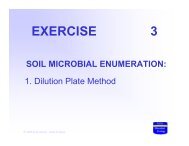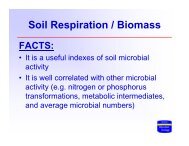Soil Microbial Ecology - Soil Molecular Ecology Laboratory
Soil Microbial Ecology - Soil Molecular Ecology Laboratory
Soil Microbial Ecology - Soil Molecular Ecology Laboratory
Create successful ePaper yourself
Turn your PDF publications into a flip-book with our unique Google optimized e-Paper software.
Page 47<br />
The most probable number (MPN) technique is a statistical approach to quantification<br />
and, as in the plate count technique, involves the preparation of a decimal dilution series.<br />
The sample must be diluted to extinction. An aliquot of each dilution (usually 1.0 or 0.1<br />
ml) is then added to a series of tubes containing a growth medium. The number of<br />
replicate tubes employed dictates the degree of accuracy. Tables are available for 3, 5, 8,<br />
and 10 tube determinations. The table below is a three-tube table. As an example,<br />
consider the following: a sample is decimally diluted to extinction. Three 1-ml aliquots<br />
from each dilution are dispensed to three tubes of nutrient broth. After incubation, growth<br />
is determined by turbidity. Any turbidity is considered a positive test. At a dilution of 10 -<br />
2 all three tubes are turbid, 10 -3 has two turbid tubes, 10 -4 has one turbid tube and 10 -5 has<br />
none. The combination is 3, 2, 1, 0 or 2, 1, 0. Referring to the table, the combination 3, 2,<br />
and 1 gives a MPN value of 1.50 for the center dilution and 2, 1, 0 gives a value of 0.15.<br />
The MPN value is multiplied by the reciprocal of the dilution. In these examples, the<br />
MPN is (1.5 x 10 3 ).<br />
THREE-TUBES MOST PROBABLE NUMBER (MPN) TABLE<br />
# OF POSITIVE TUBES # OF POSITIVE TUBES<br />
SERIES SERIES SERIES MPN SERIES SERIES SERIES MPN<br />
A B C<br />
A B C<br />
0 0 0 24.00<br />
Al-Agely and Ogram © 2004





